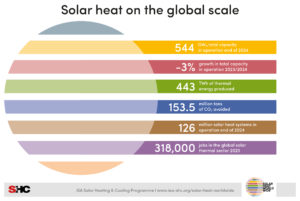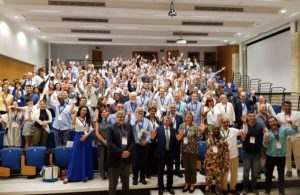“Solar thermal cooling reduces the strain on the power grid”
November 14, 2020Global IEA Solar Heating and Cooling research platform Task 65, called Solar Cooling for the Sunbelt Regions, aims to provide countries in Africa, Asia and the MENA region with specifications and know-how of solar thermal and PV air conditioning. To achieve this, researchers and manufacturers need to work together and adapt components and systems to operate under different conditions. It was thus an encouraging sign that more than 10 component producers and system integrators attended the platform’s most recent meeting in September. Solarthermalworld.org spoke with some of them about their expectations for the task and their market opportunities.
Photo: Absolicon
When asked about which direction he thinks the IEA SHC cooling platform will take, Joakim Byström, CEO of Absolicon, Sweden, responded: “The strongest market for solar thermal cooling lies in large air-conditioning systems, such as those used in hospitals and commercial buildings. Solar cooling also needs to become more prevalent in district cooling. Hence, the task could provide better data sources and more information on that kind of application.”
Absolicon offers a Solar Keymark-certified solar concentrating unit that supplies heat and steam at up to 160 °C to power absorption chillers. Two systems have already been put into operation. One is a 36 m2 solar field that provides heating and cooling for the Härnösand hospital’s radiology department in Sweden (see the photo above). The other, a 127 m2 installation consisting of T10 Absolicon collectors, is in the Spanish city of Ourense, where it powers the local hospital’s chiller to provide air conditioning.
Byström added that his company is currently working on the best possible heat source configuration for its collectors. In combination with storage and heat pumps, it is hoped to provide greater cooling fractions at competitive prices in places where irradiation is high. He said: “We are looking forward to discussing our work and exchanging ideas with other Task 65 participants.”
Solar cooling systems in Gulf countries

Agility’s solar-cooled headquarters: The logistics business based in Kuwait had 234 m² of evacuated flat plate collectors mounted on the building behind its HQ.
Photo: TVP Solar
Solar air conditioning is one of the key applications Switzerland-based TVP Solar offers to its clients. The company operates two solar thermal cooling pilot installations in the Gulf region, in Saudi Arabia and Abu Dhabi, and commissioned its first commercial system in Kuwait in 2017. Each is made up of a field of evacuated flat plate collectors produced in-house and powers double-effect absorption chillers at 160 °C to 175 °C.
“We need to join forces under the umbrella of IEA SHC Task 65 to get out the message that solar thermal cooling has additional benefits, as our systems cut infrastructure costs and reduce the strain on the power grid,” emphasised Guglielmo Cioni, Vice President Business Development at TVP Solar. He is convinced that the widespread use of electricity to power new vehicles and heating and cooling equipment will “pose a significant challenge to already strained power distribution grids”.
TVP’s joined the task to increase the competitiveness of solar thermal systems and turn solar thermal cooling into a mainstream solution, particularly in the world’s sunbelt region. Cioni added: “Based on CAPEX/OPEX alone, a combination of a PV unit and an electrically run heat pump may be hard to beat. But in a broader energy system context, solar thermal cooling provides a clear value-add too.”

A South African guesthouse with a rooftop PV-thermal installation (7 kWth and 2 kWel) that came online in March 2020
Photo: Naked Energy
Naked Energy, a UK business that produces a new kind of evacuated tube PV-Thermal collector, is another industrial member of Task 65. Its vacuum glass tubes contain standard PV cells laminated to an aluminium heat exchanger. The manufacturer also offers a heat-only variant of its Virtu collector, Solar Keymark-certified since September 2020.
“Our virtuPVT modules can drive chillers using either solar electricity or solar heat,” noted Christophe Williams, Co-Founder and Managing Director of Naked Energy. “The IEA SHC task now provides us with an opportunity to look for partners and gain a deeper insight into technical matters and the market overall, allowing us to deliver solar cooling solutions across the globe.”
So far, Naked Energy has put up two demonstration systems in Malta and Cyprus and four commercial installations in the UK, South Africa and the Netherlands. But it has yet to erect a system that provides cooling for buildings. The next virtuHot installation is planned for Switzerland.
Organisations mentioned in this article:


